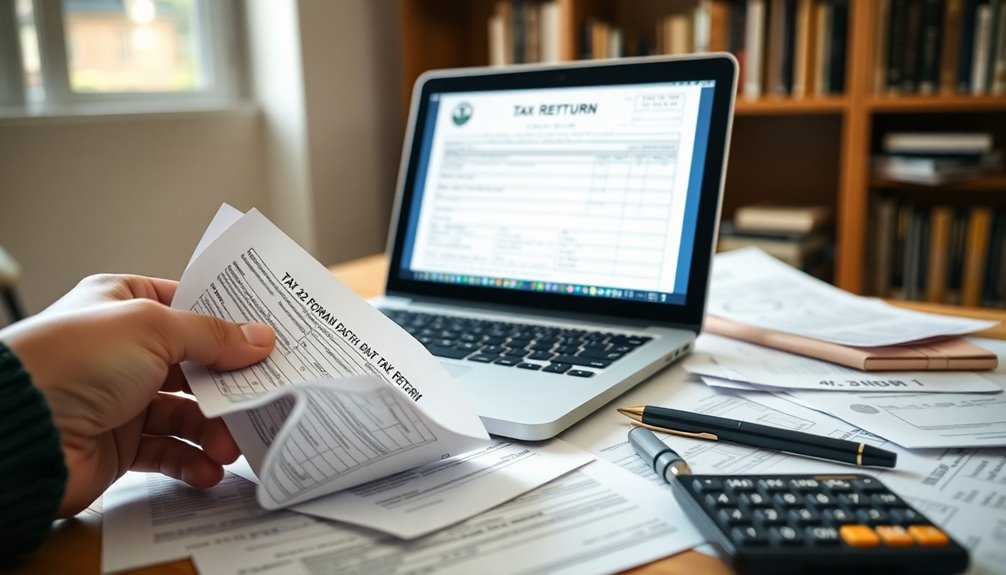Yes, you can file your taxes without a W-2 by using Form 4852. This form acts as a substitute for missing W-2 or 1099-R forms. To do this, gather your final pay stubs or other financial documents to estimate your income and the taxes withheld. You'll need to provide your personal details and your employer's information on Form 4852. Once filled out, attach it to your paper tax return and submit it to the IRS. However, keep in mind that filing this way can lead to delays or complications, so the next steps are crucial for a smoother process.
Key Takeaways
- Yes, you can file taxes without a W-2 by using Form 4852 as a substitute for missing forms.
- Gather your final pay stubs to estimate your income and federal tax withheld accurately.
- Attach Form 4852 to your paper tax return (Form 1040) and mail it to the IRS.
- Keep thorough records of your income estimations and any correspondence with your employer regarding the missing W-2.
- Be aware that filing without a W-2 may lead to delays, audits, or penalties if discrepancies arise.
Understanding W-2 Requirements

When it comes to filing your taxes, understanding W-2 requirements is essential, especially if you're an employee. Your employer must issue a W-2 form to you by January 31 for the previous tax year. This form not only reports your wages, tips, and other compensation but also includes withholdings for income, Social Security, and Medicare taxes. Additionally, W-2 forms must be furnished to recipients by January 31 to maintain compliance with tax regulations.
Make sure it arrives at your correct mailing address; if you don't receive it by the end of January, reach out to your employer.
The accuracy of the information on your W-2 matters greatly. Your name and Social Security number must match the details on your Social Security card to ensure your earnings are properly recorded.
Any discrepancies should be reported to your employer immediately, as you'll need a corrected W-2 form for your tax filing.
Filing With Form 4852

If you've lost your W-2 or it hasn't arrived, you can still file your taxes using Form 4852, a substitute form provided by the IRS.
To get started, download Form 4852 from the IRS website or call 1-800-TAX-FORM for a physical copy. You can also pick one up at a local IRS office if you need it right away. Make sure you're using the correct form for the right tax year.
When filling out Form 4852, enter your personal details, including your name, address, and Social Security number. Specify which form is missing (W-2 or 1099-R) and the tax year.
Don't forget to include your employer's name, address, and EIN. Estimate your income and federal income tax withheld using your final pay stubs or other financial documents, and provide a detailed explanation of your attempts to obtain the missing form. Filing Form 4852 prevents penalties associated with late or inaccurate tax returns, ensuring compliance with U.S. tax laws.
Once completed, attach Form 4852 to your paper tax return (Form 1040) and mail it to the IRS.
Estimating Wages and Withholding

Estimating your wages and tax withholding accurately is crucial, especially when you're filing without a W-2. Start by gathering necessary documents, such as your previous pay statements and tax returns, which can provide valuable insights into your gross pay and withholdings.
To determine your federal taxable gross, subtract any pre-tax reductions from your total gross pay. You can use the IRS Tax Withholding Estimator to adjust your withholding based on your current income and changes in tax laws. Make sure to consider any additional income, deductions, and dependents you have, as these will affect your overall tax liability. Employers have two methods for calculating withholding: the wage bracket method and the percentage method.
The wage bracket method is simpler, while the percentage method requires more detailed calculations. If you're using a manual payroll system, refer to IRS Publication 15-T for guidance. Additionally, ensure that you have the correct Form W-4 on file, as it is essential for accurate withholding calculations.
If your situation changes—like a new job or a change in dependents—submit a new Form W-4 to your employer to adjust your withholding. Regularly reviewing your withholding helps ensure you won't owe too much or receive a large refund at tax time.
Information Needed for Form 4852

Filing taxes without a W-2 means you'll need to complete Form 4852, which serves as a substitute for missing wage documents. To fill it out correctly, you'll first need to provide your personal information, including your full legal name, current residential address, Social Security number, and mailing address for correspondence.
Make sure your name matches other tax documents to avoid issues.
Next, identify the missing tax form, whether it's a W-2 or 1099-R, and specify the tax year you're filing for. Indicate whether you didn't receive the form or if it contained errors, and explain your attempts to obtain the correct version.
You'll also need details about your employer or payer, such as their full name, address, and Tax Identification Number (EIN) if available. Having the EIN is particularly important for electronic filing.
Additionally, be aware that Form 4852 is required to be attached to your tax return as it is not a standalone document.
Finally, document your efforts to obtain the missing form and explain how you calculated the figures you're reporting.
Attach Form 4852 to your paper tax return (Form 1040), mail it to the IRS, and keep a copy for your records.
Risks of Filing Without a W-2

When you file your taxes without a W-2, you're exposing yourself to several risks that can complicate the process. One major risk is delayed processing. Inaccuracies in your return may prompt the IRS to conduct additional reviews, leading to longer wait times for your refund.
You might also need to provide extra documentation to verify your income and withholdings, resulting in further correspondence. Additionally, failing to report all income from a W-2 can lead to IRS penalties and interest. If the IRS uncovers inaccuracies later, you could face fines that range in severity based on the extent of the errors. Interest may also accrue on any unpaid taxes stemming from these mistakes. Furthermore, the W-2 form is crucial for ensuring accurate income reporting and tax liability determination.
Moreover, filing without a W-2 increases the likelihood of scrutiny from the IRS. Discrepancies between your reported income and W-2 data can trigger audits, which could lead to additional taxes, penalties, and interest.
Ultimately, these risks underscore the importance of having accurate documentation when filing your taxes to avoid unnecessary complications and financial repercussions.
Potential Audit Triggers

Many taxpayers unknowingly increase their chances of an audit by making certain mistakes on their tax returns. One of the biggest red flags isn't reporting all income. If you overlook income from sources like old brokerage accounts or Form 1099s, the IRS might take a closer look. They match reported income with W-2s and 1099s, and any discrepancies can lead to an audit. Additionally, the IRS's enforcement activities have resulted in $55.2 billion in collections last year, highlighting the importance of accuracy in reporting unreported income.
Another trigger is claiming excessive or unusual deductions. If your deductions look unusually large compared to your income or seem odd for your profession, you might attract scrutiny. Be especially cautious with travel, meals, and casualty losses, as they tend to raise suspicions.
Mathematical errors also come into play. Simple mistakes, rounding numbers, or using estimations can signal sloppy record-keeping. If your return has missing schedules or inconsistent information, you increase your audit risk.
Lastly, be wary of how you report business expenses or foreign accounts. Frequent business losses or failure to comply with foreign reporting rules can raise eyebrows. Keeping your records accurate and thorough can help minimize your chances of an audit.
Contacting Your Employer

Contacting your employer for a W-2 is a crucial step if you haven't received it by the end of January. Employers must provide W-2 forms by January 31, so if yours is delayed, reach out directly.
Start by contacting your Human Resources Department or payroll provider for assistance. Even if the company is no longer in business, former payroll providers may still help you obtain your W-2.
Make sure your employer has your correct address, as this could be the reason for the delay. You might need to provide identification to verify your employment, so have your final pay stubs or other payroll records on hand to support your request.
Confirm your employer's name and address to ensure accurate communication, and inquire if they offer electronic access to W-2s or participate in early W-2 access services.
If you don't hear back, follow up with multiple contacts. Keep records of your communication attempts, and if the W-2 remains unavailable, request a statement explaining the situation. Additionally, remember that if your W-2 is missing, you can file your taxes using Form 4852 as a substitute for the missing document.
Be ready to provide detailed information about your wages and withholding if necessary.
Reaching Out to the IRS

If you're still missing your W-2, reaching out to the IRS can provide the assistance you need. Before you call, gather essential information to streamline the process.
You'll need your employer's name, complete address, and phone number, along with their identification number if you have it. Don't forget your own details, such as your name, address, Social Security number, and phone number.
When you contact the IRS, be prepared to estimate your wages, federal income tax withheld, and the dates you worked for your employer. Explain why your W-2 is missing and mention any previous correspondence you've had with your employer regarding the issue. It's important to note that filing an accurate return is essential for maintaining tax-exempt status as organizations must demonstrate responsible financial management.
Expect the IRS to help you obtain your missing W-2 and guide you on using Form 4852 as a substitute. They may also inform you about potential delays in your refund and provide instructions for filing an amended return if you receive a corrected W-2 later.
For assistance, call the IRS at 1-800-829-1040 during business hours. You can also find forms and instructions on the IRS website in the "Forms & Pubs" section.
Filing and Submission Guidelines

When you're ready to file your taxes without a W-2, it's crucial to follow specific guidelines to ensure everything goes smoothly.
Start by obtaining Form 4852 from the IRS website. This form serves as a substitute for your W-2. Complete it using your final pay stub or estimate your earnings if you don't have a pay stub. Make sure to attach Form 4852 to your annual tax return, Form 1040, since it can't be e-filed and must be submitted by mail.
Gather all necessary information about your wages, tips, and any other compensation. Include details like social security wages, Medicare wages, taxes withheld, and your employer's identification number, name, and address. It's important to note that employers are required to issue W-2 forms by January 31, so keep track of that timeline.
Accuracy is key; any mistakes could lead to penalties.
Don't forget that deadlines still apply, so file your taxes on time. If you're filing electronically, input the information that would normally appear on the W-2 but keep your W-2 safe for potential audits.
Also, be aware that state and local taxes may have different requirements, so check with those departments for specific guidelines.
Amending Your Tax Return

Amending your tax return can be necessary if you discover that a W-2 was missing or if you've made errors in your original submission.
First, wait for the IRS to process your initial return before filing an amendment using Form 1040X. You can't e-file this form; instead, print it, sign it, and mail it to the IRS, attaching the missing W-2. W-2 forms are essential for claiming tax credits and deductions, so ensuring they are accurate is crucial.
You can amend your tax return to correct errors or claim missed credits within three years of the original filing date.
If your amendment results in owing more tax, ensure it's filed and paid by the original due date to avoid penalties. Conversely, if you're expecting a refund, you have three years from the original filing or two years from when you paid the tax, whichever is later.
Frequently Asked Questions
Can I File Taxes if I Worked Freelance Without a W-2?
Yes, you can file taxes as a freelancer without a W-2.
You'll need to report your income using Form 1099-NEC if you earned over $600.
Fill out Schedule C to detail your business income and expenses, and use Schedule SE for your self-employment tax.
If you don't have a W-2, you might estimate your earnings with Form 4852.
Just remember to keep track of your business expenses for deductions!
What if My Employer Refuses to Provide a W-2?
If your employer refuses to provide a W-2, start by contacting them directly to request the form, emphasizing its urgency.
Keep a record of your attempts. If that doesn't work, call the IRS for assistance at +1-(800)-829-1040.
You can also fill out IRS Form 4852 as a substitute, using your final pay stub to estimate your income.
Don't forget to check state tax requirements to ensure compliance.
Is There a Deadline for Filing Form 4852?
There's no specific deadline for filing Form 4852 itself, but you need to attach it to your tax return by the filing deadline to avoid penalties.
If you receive your missing W-2 after filing Form 4852, compare the information and amend your return with Form 1040-X if needed.
Ensure your estimates on Form 4852 are accurate to prevent potential issues.
Keep a copy for your records until necessary to verify earnings.
Will Filing Without a W-2 Delay My Tax Refund?
Yes, filing without a W-2 can delay your tax refund.
When you use IRS Form 4852, the IRS may take extra time to verify the estimated wages and tax withholding you've provided. They might hold your return for several weeks or even months if discrepancies arise later.
To minimize delays, consider reaching out to your employer for the W-2 or requesting a wage transcript from the IRS before filing.
Can I Use Pay Stubs Instead of a W-2 for Filing?
Yes, you can use pay stubs instead of a W-2 for filing your taxes if you haven't received the W-2 by the deadline.
You'll need to gather the necessary information from your last pay stub, including total wages and taxes withheld.
Fill out Form 4852 accurately and attach it to your tax return.
Just remember, you can't e-file with Form 4852, so you'll need to mail your return instead.
Conclusion
In summary, you can file your taxes without a W-2 by using Form 4852, but it requires careful estimation of your wages and withholding. Be sure to gather the necessary information and consider the risks involved. If you're having trouble, don't hesitate to contact your employer or the IRS for help. Filing accurately is crucial, so make sure to follow submission guidelines and be prepared to amend your return if needed. You've got this!









